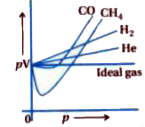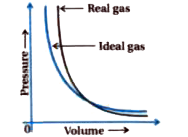Explain Real gases do not completely follow Boyle.s law, Charle.s law and Avogadro.s law under all conditions. Solution in Gujrati
(A) According of Boyle.s Law, Explanation of graph of pV→p (constant) : Theoretical value is pV→nRT. At constant temperature and all pressure, parallel to X - axis line is obtained for graph pV→p. Because parallel to X - axid straight line obtained. According to Boyle.s law for graph pV→p.
But in real graph for pV→p is not obtained straight line. In figure (graph) against are shown ast constant temperature pV→p.
This grpah is not straight line for ideal gas and shows deviation with ideal gas.

More over it is not parallel to X - axis as an ideal gas.
Graph Type - 1 : Graph of Dihydrogen and Helium are strasight line and pV increases with increasing pressure.
Graph Type - 1 : The real gas Carbon monoxide (CO) and Methane (CH4) shows different type of curve.
According to curve, CO and CH4 gas shows negative deviation with Ideal gas. Value of pV decreases with increasing in pressure.
Vaslue of pV decreases with increasing in pressure and reached at minimum value. After that value of pV increases with increasing in pressure and it intercept line of ideal gas and deviation becomes zero.
Value of pV increases with increasing in pressure and continuously positive deviation observed.
So real gases do not follow ideal gas equation in each energy condition.
(B) According of Boyle.s LAw, Explanation of deviation of graph of p→V (T constant ): Graph of p→V of real gas shows deviation than ideal gas is shown in graph, p→V curve is given according to Boyle.s Law and some experimental information.

This graph indicate that,
(i) Measured volume at high pressure (volume of real gas is higher than ideal gas).
(ii) Volume of real gas measured at low pressure it will be nearest thans volume of ideal gas.
From result of A & B. Prove that real gases do not follow Boyle.s Law, Charle.s Law and Avogradro.s Law.
Topper's Solved these Questions
- STATES OF MATTER BOOK - KUMAR PRAKASHANCHAPTER - STATES OF MATTER EXERCISE - SECTION - A QUESTIONS (Sub Question)
3 Videos
- STATES OF MATTER BOOK - KUMAR PRAKASHANCHAPTER - STATES OF MATTER EXERCISE - SECTION - A QUESTIONS (TRY YOUR SELF)
47 Videos
- SOME BASIC CONCEPTS OF CHEMISTRYBOOK - KUMAR PRAKASHANCHAPTER - SOME BASIC CONCEPTS OF CHEMISTRYEXERCISE - Section - D (Solutions of NCERT Exemplar Problems) (Long Answer Type Questions)
4 Videos
- STRUCTURE OF ATOMBOOK - KUMAR PRAKASHANCHAPTER - STRUCTURE OF ATOMEXERCISE - QUESTINS PAPER FROM MODULE (SECTION -D)
2 Videos
Similar Questions
Derive Boyle.s formula according to his law.
View SolutionAt 300 K constant temperature gas having 20cm3, 1 bar pressure it is convert into 50cm3 then calculated pressure ?
View SolutionA vessel contains 1.6 g of dioxygen at STP (273.15 K, 1 atm pressure). The gas is now transferred to another vessel at constant temperature, where pressure becomes half of the original pressure. Calculate
(A) volume of the new vessel.
(B) number of molecules of dioxygen.
View SolutionExplain Heisenberg’s uncertainty principle.
View SolutionExplain (i) Boyle's law (ii) Charle's law. Why are they not applicable to real gases in all states ?
View Solutionवास्तविक गैसे किन परिस्थितियों में बॉयल और चार्ल्स के नियमो का पालन करती है-
View SolutionExplain effect of Boyle.s law.
View SolutionGive Charle.s law in brief.
View SolutionExplain : Avogadro.s Law.
View SolutionDerive relation between density of gases and molecular mass by using of Avogadro.s law.
View SolutionGive Avogadro.s Law.
View SolutionGive Charle.s Law.
View SolutionBoyle, Charle.s Law indicates ?
View SolutionWhich equation follows Boyle.s Law ?
View SolutionWhich of the following is true according to Charle.s Law ?
View Solution
